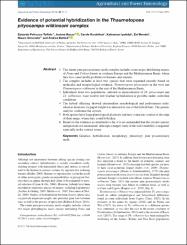| dc.contributor.author | Petrucco-Toffolo, Edoardo | |
| dc.contributor.author | Basso, Andrea | |
| dc.contributor.author | Kerdelhue, Carole | |
| dc.contributor.author | Ipekdal, Kahraman | |
| dc.contributor.author | Mendel, Zvi | |
| dc.contributor.author | Simonato, Mauro | |
| dc.contributor.author | Battisti, Andrea | |
| dc.date.accessioned | 2019-11-24T20:36:07Z | |
| dc.date.available | 2019-11-24T20:36:07Z | |
| dc.date.issued | 2018 | |
| dc.identifier.issn | 1461-9555 | |
| dc.identifier.issn | 1461-9563 | |
| dc.identifier.uri | https://dx.doi.org/10.1111/afe.12224 | |
| dc.identifier.uri | https://hdl.handle.net/20.500.12513/2078 | |
| dc.description | WOS: 000419228400002 | en_US |
| dc.description.abstract | 1 The winter pine processionary moth complex includes some major defoliating insects of Pinus and Cedrus forests in southern Europe and the Mediterranean Basin, where they also cause health problems to humans and animals. 2 The complex includes at least two species that were separated recently based on molecular and morphological evidence: Thaumetopoea pityocampa in the west and Thaumetopoea wilkinsoni in the east of the Mediterranean Basin. 3 Individuals from two populations, selected as representative of Th. pityocampa and Th. wilkinsoni, were used to test whether hybridization is possible under controlled conditions. 4 The hybrid offspring showed intermediate morphological and performance traits, whereas heterosis for pupal weight was detected in one of the hybrid lines. The genetic analysis confirmed the crosses. 5 Both species have large phenological plasticity and may come into contact at the edge of their range, where they could hybridize. 6 Based on the evidence accumulated so far, it is recommended that the current species designations are maintained, although a deeper study of the trait variability is required, especially in the contact zones. | en_US |
| dc.description.sponsorship | EU project PROMOTH [QLK5-CT-2002-00852]; University of Padua Dep. DAFNAE | en_US |
| dc.description.sponsorship | We thank M. Cappucci, P. Paolucci and D. Zovi who were involved in running the crossing experiments. We are indebted to M. P. Zalucki and three anonymous reviewers for their useful comments and suggestions. This work was funded by EU project PROMOTH QLK5-CT-2002-00852 and by the University of Padua Dep. DAFNAE. | en_US |
| dc.language.iso | eng | en_US |
| dc.publisher | WILEY | en_US |
| dc.relation.isversionof | 10.1111/afe.12224 | en_US |
| dc.rights | info:eu-repo/semantics/closedAccess | en_US |
| dc.subject | Genetics | en_US |
| dc.subject | hybridization | en_US |
| dc.subject | morphology | en_US |
| dc.subject | phenology | en_US |
| dc.subject | pine processionary moth | en_US |
| dc.title | Evidence of potential hybridization in the Thaumetopoea pityocampa-wilkinsoni complex | en_US |
| dc.type | article | en_US |
| dc.relation.journal | AGRICULTURAL AND FOREST ENTOMOLOGY | en_US |
| dc.contributor.department | Kırşehir Ahi Evran Üniversitesi, Fen-Edebiyat Fakültesi, Biyoloji Bölümü | en_US |
| dc.identifier.volume | 20 | en_US |
| dc.identifier.issue | 1 | en_US |
| dc.identifier.startpage | 9 | en_US |
| dc.identifier.endpage | 17 | en_US |
| dc.relation.publicationcategory | Makale - Uluslararası Hakemli Dergi - Kurum Öğretim Elemanı | en_US |


















